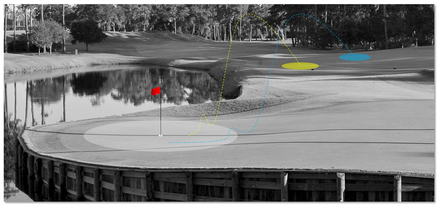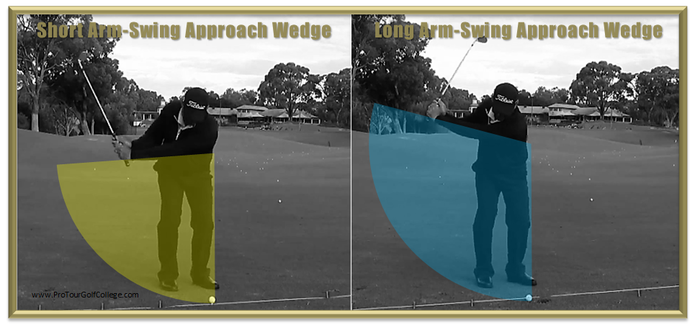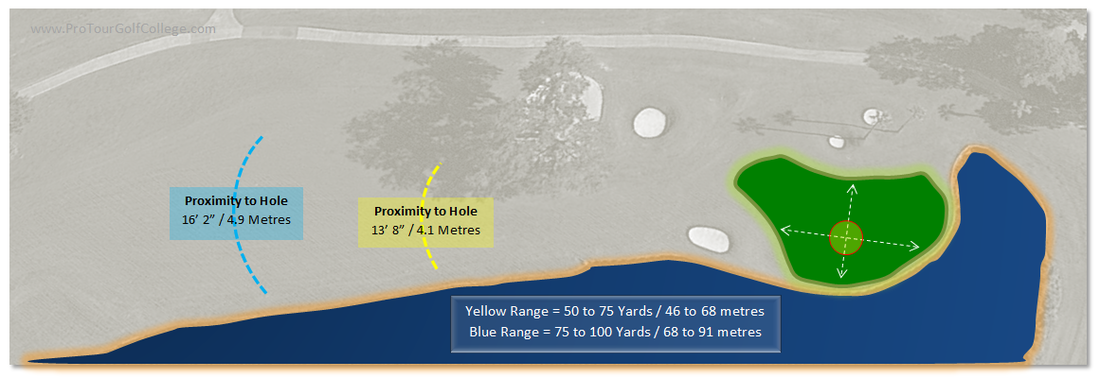|
In today’s article I’m going to show you how to make more birdies with your approach wedge shots on par 5 holes. I'm also going to show you the critical wedge distance ranges and the numbers you need to produce to make more birdies in every round to become a consistent par breaking golfer. I think we can all agree that the top male and female tour players make most of their birdies on par 5 holes? In fact the average PGA Tour player birdies about 40 percent of the entire par 5 holes he plays in a season, and the top golfers birdie closer to 50 percent. If you have been following this article series you know that the key to breaking par is based on our simple and easy to understand par breaking formula; < Par = Birdie or Better > Bogey or Worse Basically this means that you need to make more birdies than bogeys to break par, and this is the real challenge of this great game. Most of your birdie opportunities will come on the par 5 holes, and in this article I’m going to share with you a radical mind-set shift that will help you to make more birdies on par 5 holes setting you up to break par more often.  The Par 5 Paradigm Shift: The top male and female tour players all play par 5’s under par and they do this primarily because they believe that par 5 holes are challenging par 4 holes, and their goal is to birdie at least 2 out of every 4 they play. There are no more par 5 holes on your golf course; they are all par 4.5 holes from now on. The par 5 score average of the top golfers on the PGA Tour in 2013 was 4.58 from 225 par 5 holes they played. Think about that for a moment, on average these golfers were 93 under par for about 225 par 5 holes they played that season. To become a leading par breaking amateur or tour professional you need to be able to achieve (or get very close to) this 4.5 standard if you wish to become a competitive golfer who breaks par often. You also need to understand the mind-set and game of someone who plays par 5 holes as par 4.5 holes, because there are a number of factors that will influence how close to 4.5 as an average you will produce, so let’s have a look at them.  Tee Shot Distance on Par 5 Holes. If you average out all the par 5 holes you play in a season what would the average length of the holes be? It is likely to be around 550 yards (503 metres) for male golfers playing in important tournaments and slightly less at club level. The average percentage of distance covered from the tee on par 5 holes by PGA Tour players in 2013 was 52 percent. What this means is that if they are playing a par 5 that measures 550 yards (503 metres), they will hit their tee-shot at least 286 yards from the tee, which is 52 percent of the total distance of the hole.
Tour players fly their 3 wood between 220 and 250 yards (200 and 229 metres) with the long hitters able to fly their 3 woods consistently into the 250 yard range. Have a look at the par 5 16th hole at T.P.C Sawgrass below, where The Tournament Players Championship is played every year, and you can see the distinct advantage distance gives the longer hitters. A tee-shot of 290 yards on this hole will leave a second shot of 225 yards to the middle of the green. If you were in contention in this tournament a birdie on this hole (your 70th hole) could really help you, by supplying momentum and motivation for playing the last 2 holes; the treacherous par 3 17th with its island green, and the long curve-linear 18th hole par 4 that is bordered along the left with water, from in front of the tee, and all the way to the green. Many of the par 5 holes on tour are not designed to be receptive to second shots from a long way out unless you hit a truly great shot. For example, the neck of the fairway leading into the green surface on the 16th hole at T.P.C Sawgrass is just 10 yards wide, with water cutting in tight on the right, and a well placed pine tree on the left. So even though the majority of tour players playing in the Tournament Players Championship can reach this green in 2 shots, many prefer the third shot option of relying on an accurate approach wedge shot to the pin, which is tucked in the right side of the green on the last day. Now the lay up third shot must be accurate and layed up to the distance that the player is at their best. What this means is that each player has one or two distances that they are very accurate at, both in terms of direction and distance. How would you like to be playing your second shot from 225 yards out into a green designed like the one below? This is a view of the 16th green at T.P.C Sawgrass from behind the green, and you can see that going for it with your second shot is fraught with danger. Notice in this image that I have highlighted two lay up zones in yellow and blue.  Click the image to make it larger Click the image to make it larger Your 2 Colour Wedge Zones When you play par 4.5 holes like the 16th at T.P.C Sawgrass, you need to know your two wedge zones that you can hit your approach shots accurately from. With this knowledge you can be confident that from these distances you will hit your approach wedge shots close enough to the hole to give you a good chance of making the putt. The top tour players all have their favorite distances that they play their approach wedge shots from, and you should too. The key to understanding this is to realize that there are basically two types of approach wedge shots that you must become really good at;
The Yellow Zone - Short Arm-Swing Approach Wedge When you have to hit shots to tight pins on par 4.5 holes, you will need a short arm-swing approach wedge technique that has a range of between 50 and 75 yards (46 to 68 metres). Somewhere in this range you need to develop a go-to wedge shot for the tight pins that are tucked behind obstacles like bunkers or water. Your arm-swing length for this shot will have your hands just above your right hip in the back-swing, and this is one of those shots that is never practiced enough by elite golfers and it shows in their results when hitting shots from 50 to 75 yards. It is challenging to learn this shot because most of the strokes you make are made with longer arm swings and this stroke will feel very short and uncoordinated to begin with, so it will take you some practice to learn the length of the stroke and the ideal tempo for it. But hang in there because once you master this stroke you will be able to confidently get your approach shots close to hole consistently, especially when pins are tucked in tight. The Blue Zone - Long Arm-Swing Approach Wedge When you are further out from the green at the 75 to 100 yards (68 to 91 metres) range and you have to hit to tight pins you will need a long arm-swing approach wedge technique. This stroke has the handle level with your right shoulder joint or just above, is a stroke length preferred by most tour players. Remember that your wedge shot effectiveness determines how many birdies you make on par 4.5 holes. How to Practice It Wedge it closer to the hole consistently and the probability of you making mores putts goes up. The best way to practice these 2 strokes is to first determine how far you can consistently fly the ball with your short arm-swing technique and your long arm-swing technique. Hit a minimum of 5 sets of 10 golf balls (50 shots) and measure the carry distance of each shot with a laser and then average the distance out. Make sure that your arm-swing is consistent by working closely with your instructor or a friend who can provide feedback that your arm-swing is consistent and the correct length from shot to shot. Once you know how far your golf shots fly on average with both stroke lengths you can test your distance control by hitting at least 5 sets of 10 shots (50 shots) into a green and using a tape measure perform a proximity to the hole check to determine how far on average you are hitting your shots from the hole.  The Short Arm-Swing Technique from 50 to 75 Yards The Short Arm-Swing Technique from 50 to 75 Yards How Good Are the Tour Players? In the final round of the 2013 Northwestern Mutual World Challenge Zac Johnson hit his second shot into the water on the 444 yard par 4 18th hole. So he took his ball back to the drop zone and was left with a shot of about 70 yards to the pin. Now at this approach wedge distance range (50 to 75 yards) Zac's proximity to the hole is 10 feet 7 inches, (from this range in 2013 he had 20 attempts and converted 25 percent of them for birdie) so he was pretty confident that he could hit it close enough to get the ball up and down for bogey and put the pressure back on Tiger Woods. He did better than that because he holed the shot and then went into a playoff with Tiger and beat him! That's the real power of a great wedge game, because it can turn par 5 holes into par 4.5 holes. 50 to 75 Yards So how good are PGA Tour players from these distances? Well, from the 50 to 75 yards (46 to 68 metres) range the top 15 players on the PGA Tour (those who made the most birdies on par 5 holes in 2013) hit their short arm-swing approach wedge shots on average just 13 feet 8 inches from the hole, or around 4 metres away. Now this might not seem very close to the hole, but on average it really is very good, and it means that they are continually facing putts from a range that when their putter is hot they make lots of them. 75 to 100 Yards When they hit their shots from the 75 to 100 yards (68 to 91 metres) range their proximity to the hole increases just a little to 16 feet 2 inches, or around 5 metres from the pin. Consider also that on many of the par 5 holes where they played a 3 wood to the green, many times they hit their shots much closer than 50 yards from the pin during the season, and their green-side scrambling skills are so good that in 2013 (when they were hitting second shots from 250 yards to 275 yards or 228 to 251 metres away) their birdie or better result was an outstanding 62 percent for the previously mentioned par 5 birdie leaders group! So there you have it, the par 5 now becomes a par 4.5, and your job is to develop your golf skills around these key concepts, and with practice and determination you will set you up to make more birdies than bogeys, and a lot more pars in each round.
Comments are closed.
|
Archives
June 2019
|
Proudly Supported By
Copyright © 2011 - 2018 Pro Tour Golf College
Website Managed By Golf Performance Media
All Rights Reserved
Website Managed By Golf Performance Media
All Rights Reserved








 RSS Feed
RSS Feed



